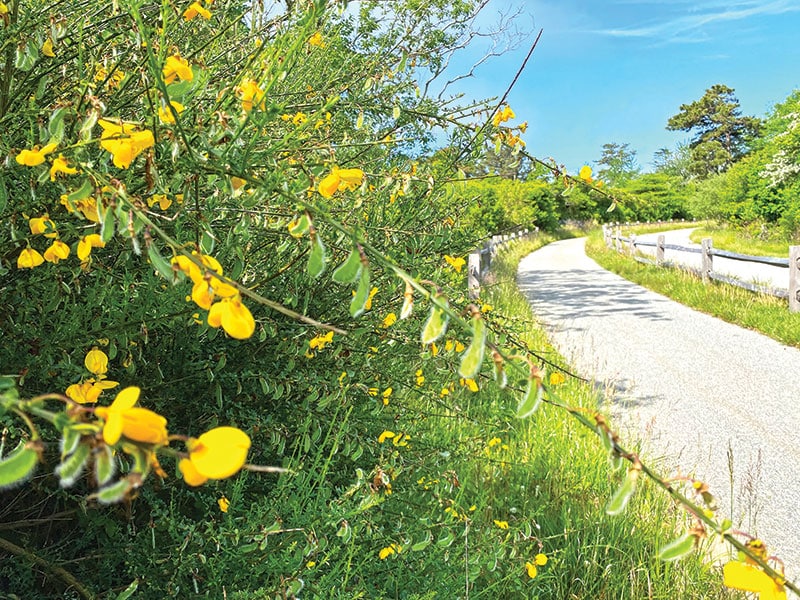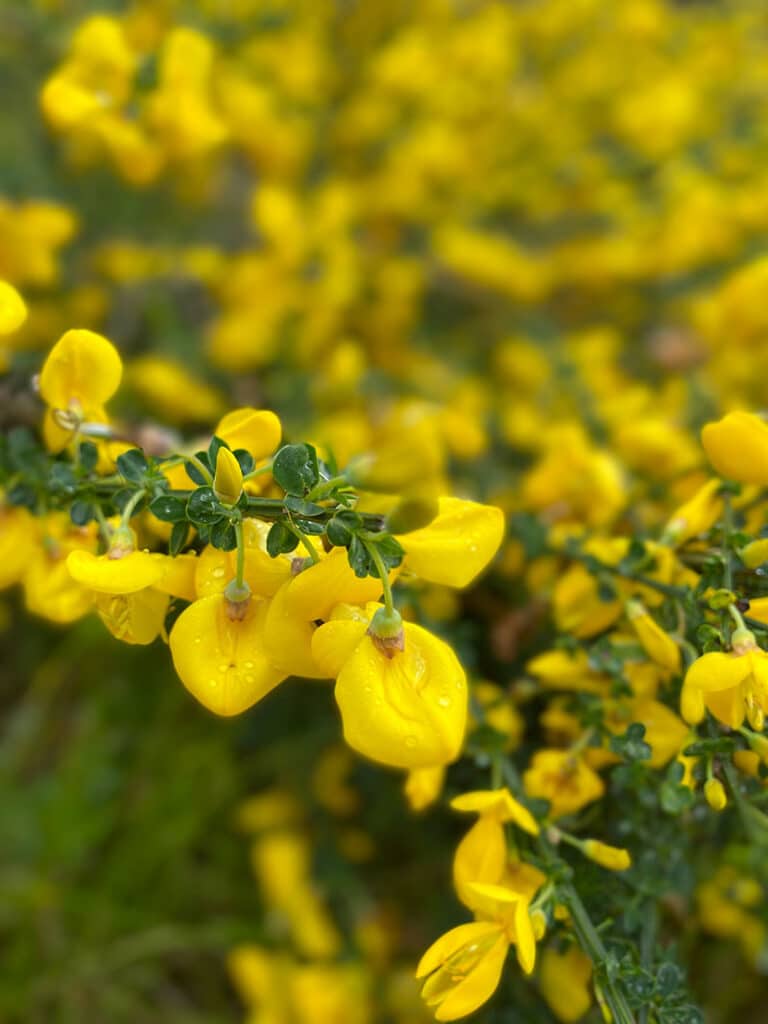by Dr. Sarah Treanor Bois
Director of Research & Education at the Linda Loring Nature Foundation
It’s that time of year again when a swath of bright yellow blooms can be seen across the island on bike paths, road edges, and conservation land trails. The non-native invasive Scotch Broom is loved by many, but is a nuisance to others. We are now finding it is becoming more invasive over time, particularly with climate change.
I first wrote about Scotch Broom in 2018 as an introduction to the idea of this plant being considered more invasive. At the time, we in the conservation world on-island had been seeing this plant showing more and more invasive tendencies. I had hoped to raise awareness about this plant and open people’s eyes to the possibility that this beautiful landscape plant could be more trouble than it’s worth. In the years since, I developed a research project around Scotch Broom to see if what we were seeing anecdotally was really something more: let the data speak for itself.

In late 2019, the New England Botanical Society (formerly New England Botanical Club) awarded me a research grant (the Les Mehrhoff Botanical Research Award) to study Scotch Broom on Nantucket, collecting data throughout the island documenting invasiveness. Throughout 2020 and with the help of several volunteers, we are close to completing our surveys and welcome any reports from the community.
Scotch Broom was first planted on Nantucket and Martha’s Vineyard in the late 1800s for a combination of its appearance and its dune stabilizing capabilities. It is well-adapted to dry, sandy soils and grows well in full sunlight: ideal conditions for Nantucket.
Scotch Broom inhabits maritime to sub-maritime cool mesothermal climates. It thrives in coastal areas due, in part, to mild winter temperatures that allow it to photosynthesize and fix nitrogen into the winter (it’s partially evergreen). Historically, Scotch Broom does not do well in areas with very cold winters. Seedlings and young plants are especially sensitive to frost, while mature plants are known to tolerate fairly severe frosts. This is likely why Scotch Broom has not spread across New England despite being naturalized in our area for more than a century.
Scotch Broom is considered by some to be an invasive plant in the northeast. However, it has not been included as an “invasive plant” under the Massachusetts state list of invasive species. In 2005, the Massachusetts Invasive Plant Advisory Group (MIPAG) previously evaluated Scotch Broom but did not add it to the list because, “Current evidence does not show that it is spreading rapidly from cultivation and out-competing native species in Massachusetts.” However, this was 16 years ago, and many things have changed. There is now growing interest in whether or not this species should be added to state banned list.
On Nantucket, we are starting to see an increase in Scotch Broom populations in natural areas, along roadsides, and bike paths. Before this plant can be considered for listing as part of the Nantucket Invasive Plant Species list or the MIPAG list, we first need to know the extent of the problem on-island. Our project involves documenting occurrences of Scotch Broom across Nantucket, focusing on conservation lands, minimally managed habitats, and other publicly accessible areas like roadsides, bike paths, and open space. This does not include private homes and areas where people are actively landscaping Scotch Broom plants.
In the past year, with the help of some excellent volunteers, we have surveyed approximately 70% of the island: the rest is being surveyed now, at peak bloom time. We have documented more than 400 individual plants outside of cultivation. That includes plants that are reproductive as well as seedlings. Of those occurrences, 74% of them occur on conserved and other open space land: minimally managed habitats. The rest are found in developed habitats. Several populations are located in areas where they could impact rare plant species. Also of concern for dispersing out of cultivation is the spread of seeds. Scotch Broom has a ballistic seed dispersal mechanism: the mature seed pods spring open, vaulting a decent distance from the adult plant.
What about all of those plants that have been here for decades? In additionto documenting what is present on Nantucket, we have been able to document changes to the naturalized populations. Nantucket is now approximately 2°C warmer than previous long-term averages. With warmer winters and earlier spring temperatures, global climate change may help Scotch Broom persist and spread on the landscape. Species like this are often called “sleeper species” – those that have been on the landscape for some time, but only becoming more invasive and escaping cultivation when conditions, such as climate, change. Others in Massachusetts include English Ivy, Kudzu, and Sweet Autumn Clematis.
This growing season, we are finalizing our initial surveys of Scotch Broom, focusing on the lesser surveyed areas of the island. Feel free to send me a message if you would like to help! As the plants mature, I will also be collecting seed pods to investigate seed viability of our local populations. Scotch Broom is a great species for research on Nantucket, since we want to learn more about this species that has flown under the radar for so long.
We hope that by documenting Scotch Broom occurrences, we can demonstrate, to MIPAG, the invasive tendencies of Scotch Broom, its reproductive potential, and its potential impact on the surrounding landscape. Listing as invasive at the state level would help on Nantucket prevent further planting. It would also help us in our education of the community to remove or otherwise manage Scotch Broom populations.
How can you contribute to Scotch Broom research and management?
• If you’d like to volunteer to collect data, contact Dr. Sarah Bois at stbois@ llnf.org.
• See an occurrence? Take photos of the plant, any reproductive evidence, and habitat. Send these to Sarah Bois: stbois@llnf.org
• Stop the spread – don’t plant any new Scotch Broom and be sure to manage any you ma already have in your landscaping. Or remove it!



